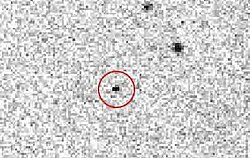Callirrhoe (moon)

Spacewatch image from 1999
|
|
| Discovery | |
|---|---|
| Discovered by | Spacewatch |
| Discovery site | Kitt Peak National Observatory |
| Discovery date | Oct-Nov 1999 |
| Designations | |
| S/1999 J 1 1999 UX18 |
|
| Orbital characteristics | |
| 24,099,000 km | |
| Eccentricity | 0.2796 |
| 758.82 d (2.1 yr) | |
| 107.962° | |
| Inclination | 147.080° |
| 283.104° | |
| 23.909° | |
| Satellite of | Jupiter |
| Physical characteristics | |
| Dimensions | ~8.6 km |
| Albedo | 0.04 (assumed) |
| 20.7 | |
Callirrhoe (/kəˈlɪroʊˌiː/ kə-LIRR-o-ee; Greek: Καλλιρρόη), also known as Jupiter XVII (17), is one of Jupiter's outermost named natural satellites. It is an irregular moon that orbits in a retrograde direction. Callirrhoe was imaged by Spacewatch at Kitt Peak National Observatory from October 6 through November 4, 1999, and originally designated as asteroid (1999 UX18). It was discovered to be in orbit around Jupiter by Tim Spahr on July 18, 2000, and then given the designation S/1999 J 1. It was the 17th confirmed moon of Jupiter.
Callirrhoe has an apparent magnitude of 20.7, making it even fainter than dwarf planet Eris at magnitude 18.7. Jupiter is about 2.5 billion times brighter than Callirrhoe.
Callirrhoe is about 8.6 kilometers in diameter, and orbits Jupiter at an average distance of 24.1 million kilometers in 758 days, at an inclination of 141° to the ecliptic (140° to Jupiter's equator) with an eccentricity of 0.28. This object was probably captured long ago from a heliocentric orbit and the Sun's gravitational influence makes this orbit highly erratic.
...
Wikipedia
